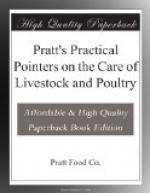While Pratts Baby Chick Food need not be fed longer than the first three weeks, it is good practice to continue its use for two to three weeks longer. But at any time after the critical twenty-one day period one may safely begin to substitute a somewhat coarser and heavier developing or growing mash for the baby chick food. We advise the use of Pratts Buttermilk Growing Mash. Here is a good home-made mixture:
Growing or Developing Mash
Cornmeal 10 lbs. Wheat Bran 20 lbs. Feeding Flour 10 lbs. Fine Ground Oats, Sifted 10 lbs. Fine Fish or Beef Scrap 10 lbs.
-------------------------------------------------------
---------- "The regular use of Pratts Poultry Regulator in the ration for growing chicks prevents deaths from common disease, increases the appetite and hastens growth. This means less loss, earlier laying or market maturity, bigger profits.
P.G. PLATT, Sec. Delaware Co. Poultry Assn., Wallingford, Pa.” ------------------------------------------------------------
-----
At six to eight weeks of age, or as soon as the youngsters can comfortably eat coarser grains, the fine scratch feed may be replaced by a coarser mixture. Equal parts, by weight, of cracked corn and wheat, form the basis of this, with barley, heavy oats, kafir corn and buckwheat added for variety if available at reasonable prices. When the flock is weaned and well feathered, the regular laying mash may be substituted for the growing mash, though the latter may well be continued for a much longer period.
Above all things, see to it that nothing but feed of superior quality is supplied. Moldy, chaffy, grains and weed seeds may be cheaper to buy than sweet, sound materials, but the latter are cheaper to feed.
Begin giving green food when the chicks are three or four days old, cutting it up finely so they can eat it. And continue to feed greens liberally at all times. It’s good for the health and cuts feed bills, too.
Care of the Growing Chicks
As the chicks grow, provide larger quarters if the original coops are at all crowded. And teach the youngsters to roost early, especially where brooders are used, so they will not “pile up” in corners when the heat is removed. When the brood is five to six weeks of age place low roosts, lath tacked on six to eight-inch boards, in the coops. The sturdier individuals will soon learn to use them and educate the rest of the flock.




